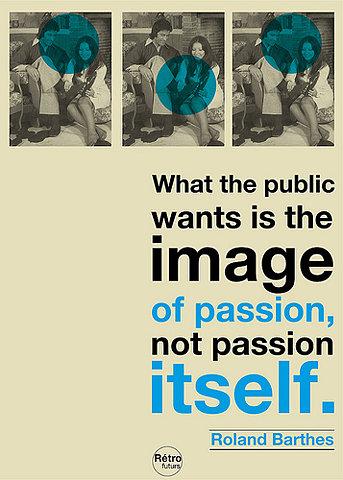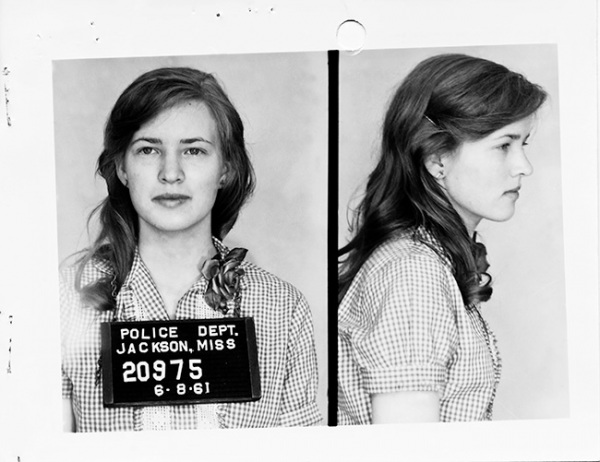Roland Barthes is a key figure in international intellectual life. He is one of the most important intellectual figures to have emerged in postwar France and his writings continue to have an influence on critical debates today. Barthes was notoriety is based on his left-wing attacks on the bourgeoisie in which he blended Existentialism, semiotics and linguistic hedonism. Barthe’s thesis that the author is dead; writing being beyond the control of the individual author, was an exaggeration, but more importantly, he introduced important themes on Postmodernism.

"His model of second-degree or parasitical sign systems allows for the process of demystification by a process of foregrounding the construction of the sign, of the would-be natural texts of social culture. Myth is to be found at the level of the second-level sign, or at the level of connotation. Barthes makes a distinction between denotation and connotation. Denotation can be described, for the sake of convenience, as the literal meaning. Connotation, on the other hand, is the second-order parasitical meaning. The first-order sign is the realm of denotation; the second-order sign the realm of connotation and, therefore, of myth. To put it crudely then, the important `lesson' of `Le Mythe aujourd'hui' is that objects and events always signify more than themselves, they are always caught up in systems of representation which add meaning to them."
“Anti-bourgeois, standing apart from the French academic scene, initially an Existentialist and always anti-essentialist, Roland Barthes came to prominence with the 1957 publication of Mythologies, a ferocious attack on French society. Barthes was a hedonist, and argued for fluidity and plurality, in outlook and social behaviour. Contemporary criticism was ahistorical, he complained, psychologically naive and deterministic, covertly ideological, bovinely content with the one interpretation. Barthes asserted that no language use can be separated from structures of ideology and power. In works which followed, Barthes claimed to have unmasked the pretensions of Romanticism and Realism. If the first overlooked the sheer labour of writing, aiming for an art that conceals art, literature in the second becomes a servant of reality and therefore anti-art.

" The text which the lover weaves in Barthes's A Lover's Discourse (1978) does not have narrative or purpose but becomes a 'brazier of meaning' as the ambiguous signs of the loved one's behaviour are interpreted. Such behaviour is 'scriptible' — is rewritten by the lover as he reads them, just as we rewrite a text in reading it."
Barthes distinguished the clerkly écrivant (who uses language to express what is already there, if only the contents of his thoughts) from the nobler écrivain (who is absorbed into the activity of writing, labouring away towards new elaborations and meanings). In practice a writer might express both aspects, but the more honest and important writer was the écrivain, whose incessant labours did not adopt the ideologies of the bourgeoisie, but bridged the gulf between intellectuals and the proletariat. Writers worked as everyone else worked, and their efforts should not be smoothed over as inspiration of a favoured spiritual class. ( C. John Holcombe )
Towards the end of Roland Barthes’ (1915-1981) “Mythologies” and interspersed with is forms of attack on the “bourgeoisie norm”, he returns to one of his central themes; an insistence that what is called human nature in a capitalist society is essentially, a set of customs that are convenient and profitable for the dominant class. In all this there is an evident implication that a myth, in the special sense under scrutiny, is a piece of ideological double talk comparable to an “écriture” with allowances for the frequent use of images or actions or other substitutes for words.

" The paste-like material of dreams provides a kind of creativity that is not represented by a stable and abstract structure. Paste can be touched. The Citroen DS could only be timidly caressed because, as says Barthes, "the touch is the most demystifying sense of all senses, contrary to sight, which is the most magical one." According to Barthes, the Citroen DS is shiny, "as smooth as cake icing" and symbolizes perfection. Excelling in "lightness," the Citroen DS produces a "silence of a marvelous order" which Barthes classifies as the silence of heavens."
A concluding chapter, entitled “Myth Today” , renders the linguistic analogy explicit. Here Barthes makes his first detailed venture into semiotics, the general theory of signs and symbols; and the result, while often heavy going, is the elaboration of a theoretical structure that has the merit of being applicable to many matters besides those evoked in “Mythologies”
Briefly, the idea is that a “myth” is a semiotic operation on two interlocking levels. On the first level, which is that of all ordinary language operations, there are three elements: the “signifier,” the “signified,” and the sense that emerges from the signifier-signified relationship, which Barthes confusingly chooses to call the “sign”. On the second level, which is where mythicizing occurs, there are again three elements, but here the “sign,” or sense , that emerged on the first level is converted into a “signifier” and used to generate a new sense; one, two, three on the first level, and then bingo, three, four, five on the second level. To put the matter more crudely, the mythmaker is both a misappropriator of signs and a semiotical con man who steals a meaning and uses it to say something else.
which pricks me (but also bruises me, is poignant to me)” (Camera Lucida, of course). For me, it’s the flower on her lapel catching in its petals the chain from the police identification board hanging around her neck, after her arrest. Evoking both vulnerability and defiance, that “minor” sartorial detail, as Barthes puts it, bruises me, is poignant to me, even as I am wary of those other dangers.”]
Barthes draws one famous example from a magazine he once saw in a Paris barbershop of a young black African dressed in a soldier’s uniform ( see above ) . Here the advantages, for the mythmaker, of the two semiotic levels are evident. The picture of the African is not in itself a symbol of French imperialism, nor in any way a stimulator of bogus sentiment; in fact, it is an image that on the first level is rich, frsh and utterly blameless. And so, when misappropriated for the second level, it may seduce an unwary viewer in a fashion beyond the capacity of an imperial symbol or straight propaganda.

"In the many (auto-) biographical materials devoted to these 'new women' in the early 1950s, a pattern clearly emerges. First, the female body needed to be strengthened, in order to be physically up to this new type of work that bore no semblance to the labor more tradionally associated with women. Secondly, once the workings of the equipme
ere mastered, a symbiotic relationship emerged between the body and the machinery."American should have no difficulty in finding similar examples of mythmaking in more recent history; from Vietnam, to 9/11 to Iraq, the Patriot Act and beyond, there has always been a lavish use of the favorite White House first-semiotic-level manouver: an expression of concern, in itself perfectly legitimate, over national security. Governments bent on dubious adventures are not, of course, the only offenders, nor the most important. The advertising agencies have been working on the two semiotic levels so long that they can do it sometimes just for laughs, like an actor spoofing a role he has played too often. Militant conservatives have their law-and-order brand of obscurantism. Militant leftists had their soviet tractor girls and so on.

Eleanor Antin. The last days of Pompeii:"(…) “Roland Barthes claimed that it is impossible to see a photograph, since we characteristically look at, and for, what it represents. Photography, almost invisible, is subsumed by its referent—a face, a person, or a place, but also a character, a type, a pretense. In Antin’s tableaux there is a remarkable stillness to the images, as if they embody, even proclaim, a “perfect moment” of representation. In this respect they are monumental and descriptive, precious and ephemeral, traits they share with both portraiture and pornography. At the same time they are also excessive, another attribute of the allegorical, not only in their ornamentality, but in their figural range as well. But perhaps their most surprising effect is that they bring about an unexpected reflection on the photographic itself.” (…)"
Obviously, all noble-minded activities, precisely because they are in themselves noble-minded, offer excellent structures for mythmaking in the Barthesian sense. Every earnest town planner is dauntingly familiar with the fact the “urban renewal” on the first semiotic level frequently signifies, on the second level, ” get the poor out”, and every environmentalist is aware of how easily the term “ecology” can come to mean you’re a dirty polluter if you don’t agree.
A great deal of the fiercest criticism in “Mythologies” , however, is directed against the myths that are not so much concocted as secreted; to some extent by all of us, although most insistently by the lower middle class, the silent majority, and its leaders. These myths are characterized by a number of ugly little fooling devices that function as “rhetorical figures” in the semiotic system. One such is “vaccination,” the familiar trick, much prized by “liberal” reactionaries, of admitting a small evil in order to ignore a large one.

"yet if one subscribes to the musings of social theorists like Barthes, is there not the risk of relegating photography to documentarianism, and excluding it from a form of exposure? How do you view/approach your work - art, journalism, sociological study, something else? I have never thought of Barthes as being so problematic when it comes to photography. He does say some things that are limiting, but in the end he leaves a lot of flexibility in his interpretations of it. Just to insert one very apropos quote: "Photography is a captive of two intolerable alibis. On the one hand, 'ennobled art pictures.' On the other hand, 'reportage' which derives its prestige from the object. Neither conception is entirely correct. Photography is a Text, a complex meditation on meaning." I think his analysis of the way photographs operate subjectively is very poignant. A funny detail in relation to Barthes and my project--apparently he started writing Camera Lucida as an attempt to understand his connection to a photograph of his recently deceased mother."
Another, more subtle device is “identification” , the refusal to grant the integral difference of other people; this can have the convenient effect, for example , of making black or poor people and their specific problems practically invisible to an affluent white man. Still another “figure” is the flat tautology:”A is A and B is B because that’s how things are.” Another is the “neither-nor” locution that balances issues in order to get rid of them. All these devices can seem to reflect proverbial wisdom, and are thus examples of the fake “naturalness” , the “display of what-goes-without -saying”, that often hides “ideological abuse”.
“what the photograph reproduces to infinity has occurred only once: the photograph mechanically repeats what could never be repeated existentially”.
roland barthes, camera lucida 1980
a





 COMMENTS
COMMENTS